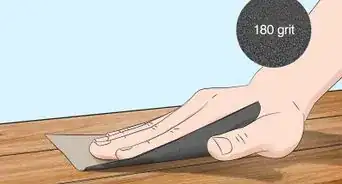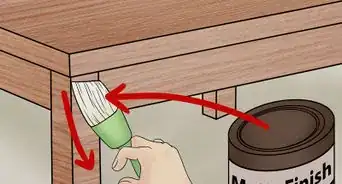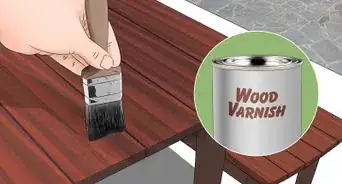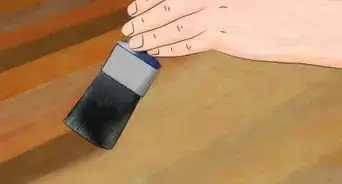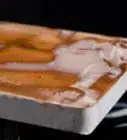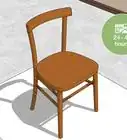This article was co-authored by Jeff Huynh. Jeff Huynh is the owner of Moseybolt, a full service solution in home services, renovations, and repair in the Greater Seattle area. He has over five years of handyman experience. He has a BS in Business Administration from the San Francisco State University and his Certificate in Industrial Electronics Technology from North Seattle College.
wikiHow marks an article as reader-approved once it receives enough positive feedback. In this case, several readers have written to tell us that this article was helpful to them, earning it our reader-approved status.
This article has been viewed 420,712 times.
Distressing wood furniture is a great way to add some character to your home. Vintage, antique, and worn-down furniture has a charm to it that new furniture often does not. One option for achieving this look without spending a fortune on antiques is distressing the furniture yourself. By following a few steps and learning a few techniques, you can quickly learn how to distress wood furniture to achieve a charming, aged look.
Steps
Prepping Your Furniture
-
1Choose a piece of furniture to distress. If this is your first time distressing a piece of furniture, do not use a prized or expensive piece. Instead, buy a cheap piece of used furniture from a thrift store or an online auction. This will ensure that you won't ruin a favorite piece if you are unhappy with the results of your project.
-
2Protect the area or move the piece to a different location. You're going to be doing lots of sanding, painting, and chipping, which means the area you're in is going to get dirty. Cover the area (and other pieces of furniture) with tarps or newspapers to protect them from sanding dust or splattered paint.
- Or just take your piece and move it to the backyard. Whichever.
Advertisement -
3If it's painted a color you don't like, use a paint stripper. What color is on your piece right now, whether you paint over it or not, is going to show through once you distress it. So if you don't like the color, you'll need to get it off. You could sand it off, but that'll take ages. A stripper goes much faster. You simply just rub it on, wait for the paint to bubble, and chip it off.
- Lots of people skip this stage. If you do, you'll still have a piece, but it won't look as good as you want it to. Take the extra time to make it look perfect by buying paint stripper (and using it).
- Once stripped, you may need to do some sanding. There will likely be a few chips of paint that are stubborn and won't come off – for those, grab your sandpaper.
-
4Consider adding a stain to a bare wood piece. If your piece has no paint on it and is just the wood as is, you may want to add a stain. It can mute the paint that's to be added, giving it a vintage-y feel. It'll also look nice if it pops through, too (if you're only doing one color of paint, that is).
- To do this, just take a clean rag, dip it in the stain, and rub it in circles. The natural grain of the wood will still show through. And if you're concerned about the circles showing through, they won't through your next coat of paint.
-
5If you're okay with the current color, begin sanding. Sand the piece of furniture with coarse-grit sandpaper. If the furniture is unfinished, you just need to sand enough to achieve a smooth surface the paint can adhere to. If the furniture already has a stain or a coat of paint on it, sand away most, but not all, of the finish. Letting the old finish show through unevenly will help contribute to the weathered look of the final piece.
- 80-grit sandpaper is a good place to start.[1] As you're sanding, keep an eye on how much of the original layer will still pop through. Some people like quite a bit creating a more speckled look while others like the undertones to be more of a subtle surprise.
-
6Wipe the entire piece down with a tack cloth. This will remove any dust from the sanding process. You want to work with a clean piece of furniture free from dust and excess anything.
Painting Your Furniture
-
1Paint your base color. Right now you have two options: you could use one color, your base color, and have that be the overall color of your piece. The distressed bits that show through would then be from the wood itself. Or you could have this be your base color, sand it and add wax, paint a color over top of that, and then sand it again, so the base color is the bit that pops through. Both will lead to beautiful pieces.
- Always work in thin, even layers. It'll take longer, but it'll be worth it. Paint with the grain in a thin coat around the entire object, let it dry, and repeat until you get the color you want. This way you can control the shade at a more precise level and no area gets gloopy with excess paint.
-
2If you're using two different paint colors, add on wax to the places you want the base color to pop through. This step is optional and is only necessary if you're working with two paint colors. The wax is a protectant, keeping the top coat of paint away from the bottom color.
- Take candle wax or petroleum jelly to the areas you want to distress. Most likely these will be corners, edges, and places that "got overly handled." These are the places you want the color to poke through.
-
3Sand the piece to simulate wear. If you are not using a second paint color, use coarse-grit sandpaper or a sanding block to rub vigorously against the furniture's corners and edges until you achieve an uneven, rounded surface. This will give the furniture a weathered look and essentially the brunt of the job.
- If you are using a second color, still do this step, just not as much; you'll be painting over most of it anyway.
-
4Paint your top coat, if desired. This top coat does not have to be beautiful; in fact, the less beautiful it is, the more distressed your piece is going to look. Have it be extra thin in some places so the base color or sanding shows through. The more worn and torn the job looks, the better.
- Do paint over the wax – that's what it's there for. Again, work in thin, even coats – not with gloopy pools of paint. Once finished, let it dry.
-
5Rub steel wool over the wax, if applicable. The steel wool won't do much damage to your top coat – not that it matters anyway (you want it to look distressed, after all). Rub it over the wax, getting it off so that the base coat of paint shows through.[2]
- After this stage, rub over the entire piece with a clean tack cloth. Right now, you're basically done. Now all you can do is add some extra finishing touches.
Adding Extra Wear and Tear
-
1Add cracks to the wood using a chisel and hammer. If you want to add cracks to the furniture, you will need a chisel and a hammer. Place the chisel against the wood in the place you want the crack to form, remembering that wood will only crack along its grain. Tap the hammer against the chisel repeatedly until a crack begins to form. Reposition the chisel along the crack if you want to extend it further.
- Use a hammer to add light depressions to the piece. To make the surface of the furniture appear worn, tap it in various places with a hammer to form small depressions.
EXPERT TIPJeff Huynh is the owner of Moseybolt, a full service solution in home services, renovations, and repair in the Greater Seattle area. He has over five years of handyman experience. He has a BS in Business Administration from the San Francisco State University and his Certificate in Industrial Electronics Technology from North Seattle College.Professional Handyman
 Jeff Huynh
Jeff Huynh
Professional HandymanGet creative with your distressing technique. Jeff Huynh of Handyman Rescue Team says: "There are a lot of different ways you can distress furniture. For instance, you can use a belt sander or an angle grinder along the edges of the piece to make them look aged."
-
2Use a wire brush to put light scratches in the furniture. Rub a wire brush along any places in the furniture's finish where you want to add scratches. This can also be done after you stain or paint the piece.[3]
- Try to make them look accidental and not deliberate. Make the scratches light and at various angles – not straight, thick lines.
-
3Use a drill to create small holes in the furniture. Use a drill with a small drill bit to drill very small holes into the furniture if you'd like to up the distressed quotient. Cluster a few holes together to simulate worm or insect damage. This can make the piece seem previously used, too.
- This part is entirely optional. If you're not comfortable drilling holes into your furniture, don't do it. Scratches and paint distress are enough.
-
4Replace any metal hardware with antique hardware. Any shiny metal parts on the furniture will undermine the aged look you want to achieve. Fortunately, antique hardware (including reproduction hardware) is a booming business; search online to find replacement parts for your furniture's latches, pulls, feet, and screws.
-
5If desired, apply a wood stain to the furniture and seal with varnish. Start by cleaning the furniture again with a tack cloth, and then brush the stain on in the direction of the wood grain. Wipe the stain off with a cloth after applying it; this will leave just enough stain accumulated in the cracks and dents you've created to highlight those features.
- When the stain is dry, seal it with a coat of clean varnish. Make sure it's a non-yellowing varnish as certain ones (like regular polyurethane) will change color over time, destroying the look.[4]
-
6Finished.
Things You'll Need
- Wood furniture
- Paint stripper (optional)
- One or two colors of paint (optional)
- Coarse-grit sandpaper
- Tack cloth
- Chisel
- Hammer
- Wire brush
- Drill
- Antique hardware
- Wood stain
- Clean cloth
- Clear, non-yellowing varnish
References
- ↑ http://www.thisoldhouse.com/toh/photos/0,,20209701_20476955,00.html
- ↑ http://www.hgtv.com/handmade/how-to-distress-furniture-/index.html
- ↑ http://www.repair-home.com/resources/how-to-guides/how-to-distress-wood.html
- ↑ http://www.hgtv.com/kitchens/distressed-and-antiqued-kitchen-cabinets/page-3.html
About This Article
To distress wood furniture, start by sanding the entire surface with coarse-grit sandpaper to create a smooth base for the new paint to adhere to. Next, give the furniture a new coat of paint, use coarse-grit sandpaper or a sanding block to achieve an uneven, weathered look, and apply the top coat of paint. If you want a more distressed look, add cracks, holes, and scratches to the surface and replace the current hardware with antique or weathered pieces. For tips on adding varnish, read on!





